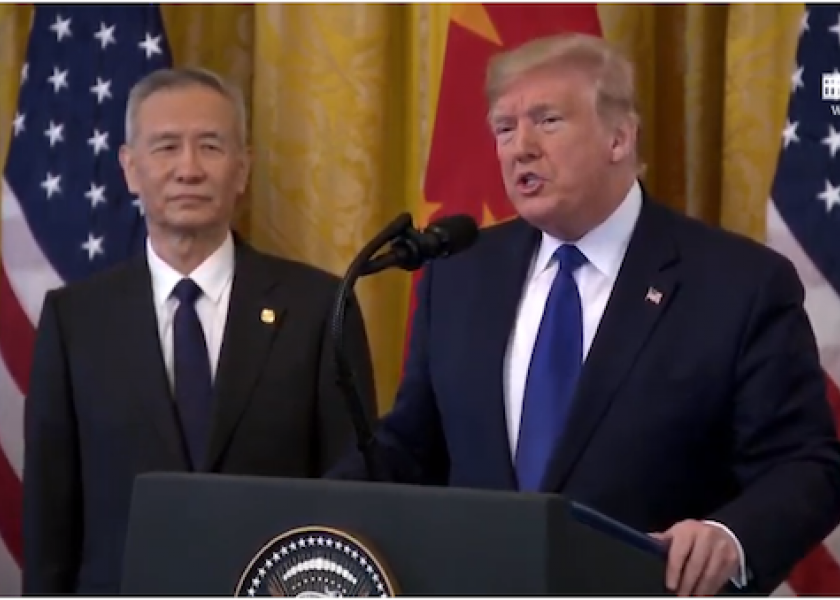Phase 1 China Deal Signed Clearing Way for $80 Billion in Ag Purchases

A phase one trade deal with China is official, clearing the way for America’s chief trade competitor to purchase $80 billion worth of U.S. agricultural goods over the next two years.
President Donald Trump was surrounded by leaders from agriculture and other impacted industries as he and Chinese Vice Premier Liu He signed the agreement after 18 months of rancorous negotiations and tit-for-tat tariffs.
"Our efforts have yielded a transformative deal that will bring tremendous benefits to both countries," Trump noted at the signing ceremony. "We have a great relationship with China. We have a great relationship with the leadership of China, and China fully understands that there has to be certain reciprocity."
That sentiment was echoed by Vice Premier Liu.
"China and the United States, with the larger picture in mind, have taken a serious approach to our differences and worked to manage them appropriately, reaching the phase one trade agreement," Liu said. "It is good for China, for the United States and for the world."
According to the chief agriculture negotiator for the U.S. Trade Representative’s office, Gregg Doud, the agreement calls on China to hit the $80 billion in ag purchases over a two year period with the amount projected to be slightly under $40 billion in 2020 and slightly over that mark in 2021. Those ag purchases are part of a larger agreement for China to purchase a total of $200 billion in U.S. goods.
While the mix of the planned ag commodity purchases is not clear, past purchases do provide a bit of a roadmap.
“We speculate it will be upwards of maybe 35 million metric tons of soybeans, a couple million tons of cotton, maybe 5 million tons of corn, two to four million metric tons of wheat, maybe 5 million tons of DDGs (distillers dried grains) and 2 million tons of ethanol,” speculated Dan Basse, president of AgResource Company. “Now that will only encompass about $30 billion, slightly less than that. Other goods will come into there, but that’s pet food, it’s lumber products, it’s all of that. But the heart of it, we believe, will be soybeans, pork, meats and, of course, some dairy.”
While the phase one agreement has plenty of good news for agriculture, there is still a tremendous amount of unfinished business between the two nations that could stall further talks. Most notably, the agreement does not roll back most of the tariffs put in place by both countries.
“The upside is we’ve stopped escalation of the trade war, but we haven’t gotten to rolling back the tariffs, that’s what’s missing,” explained Ian Sheldon, the Anderson Chair of Agricultural Marketing Trade and Policy at Iowa State University. “In no place does the deal mention Chinese industrial policies and subsidies, particularly towards their state-owned enterprises, and this was one of the most fundamental issues that started the trade war in the first place.”
The U.S. and China have not yet set a date to begin negotiations for phase two of the trade talks. President Trump said the phase one deal does settle significant trade sticking points such as intellectual property protections and forced technology transfer, though details of those protections will not be known until the full text is released.
Senate Finance Committee Chairman Chuck Grassley (R-Iowa) noted the work remaining in the subsequent trade talks with China.
"Farmers have borne the brunt of retaliation throughout this trade war. At the White House today, I was thinking of my neighbors in Iowa and all the other farmers across the country who have stood strong throughout this process,” Grassley said. “I hope this proves to be a turning point in our economic relationship with China, but I’ve seen enough history to be clear-eyed. Not only must China follow through with its commitments in this Phase One deal, but also work toward a comprehensive agreement that ends forced technology transfers, intellectual property theft and unfair restrictions on U.S. goods, including agriculture. Only then will we know if China can be a reliable economic partner in the 21st century.”







